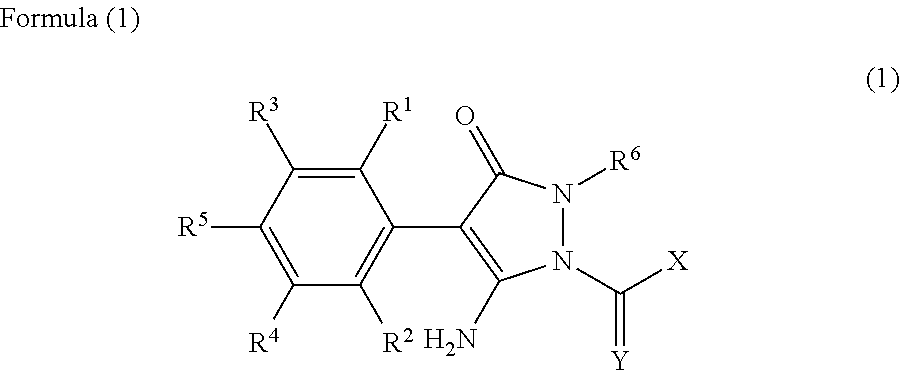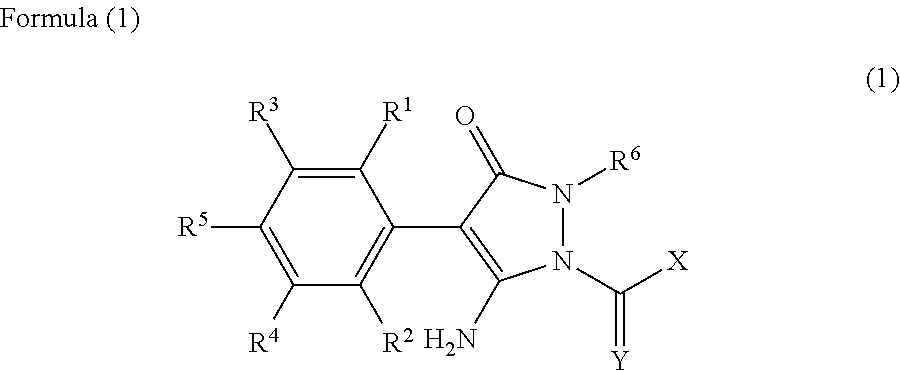Method for Purifying a Pyrazolinone Derivative
a technology of pyrazolinone and derivative, applied in the field of purifying a pyrazolinone derivative, can solve the problems that the purification method by column chromatography is not necessarily industrially easy, and achieves the effect of improving the purification efficiency
- Summary
- Abstract
- Description
- Claims
- Application Information
AI Technical Summary
Benefits of technology
Problems solved by technology
Method used
Image
Examples
example 1
Preparation of a Solution (2-1) Containing a Derivative (1-1) and a good solvent
[0071]To a mixture of 24.8 g of 4-(2-methylphenyl)-5-amino-1H-pyrazol-3-one (131 mmol), 54 g of xylene and 12 g of water, 19.5 g of a 28% aqueous solution of sodium hydroxide (136 mmol) was added dropwise while stirring at room temperature (approximately 25° C.) to dissolve the solid content therein. To the obtained dissolved solution, 50 g of methanol was added, and the resulting mixture was cooled to 15° C., and to the mixture, 40.5 g of a xylene solution containing S-(2-propenyl)chlorothioformate at 50.5% (149.3 mmol) was added dropwise over 2 hours. At the same time as the addition, to the mixture, a 28% solution of sodium hydroxide was added dropwise to maintain pH around 11.5. At the completion of the addition, the amount used of the 28% aqueous solution of sodium hydroxide was 12.3 g (148.9 mmol). The mixture after the completion of the addition was maintained at 15° C. for 1 hour, and then heated...
example 2
First Step
[0084]In a container equipped with a retreat curve agitator, 800 g of hexane was charged, and then the hexane was cooled to 5° C. Next, to the hexane, 56 g of the solution (2-1) was added dropwise at the temperature over 1 hour.
[0085]Precipitation of crystals was not found in the obtained mixed liquid.
Second Step
[0086]Using the same container in the first step, the obtained solution was stirred at approximately 5° C. for 2 hours, and precipitation of crystals was found.
Third Step
[0087]Using the same 2 L of container in the second step, to the solution containing crystals obtained in the second step while stirred at 570 rpm by a retreat curve agitator at approximately 5° C., 500 g of the solution (2-1) was added over 2 hours. The obtained mixture was stirred at approximately 5° C. for another 2 hours. In this case, the stirring power of the retreat curve agitator was 0.4 kW / m3.
[0088]The obtained mixture was filtered to obtain granulated substances wherein the main component...
example 3
[0090]To the solution of the second step obtained in the same manner as in Example 1, while stirred with a retreat curve agitator, 750 g of the solution (2-1) was added dropwise over 3 hours while maintaining at approximately 5° C. The obtained mixture was stirred at the same temperature for another 2 hours.
[0091]The content of the derivative (1-1) contained in solids of the above granulated substances was 97% or more.
PUM
| Property | Measurement | Unit |
|---|---|---|
| solubility | aaaaa | aaaaa |
| boiling point | aaaaa | aaaaa |
| boiling point | aaaaa | aaaaa |
Abstract
Description
Claims
Application Information
 Login to View More
Login to View More - R&D
- Intellectual Property
- Life Sciences
- Materials
- Tech Scout
- Unparalleled Data Quality
- Higher Quality Content
- 60% Fewer Hallucinations
Browse by: Latest US Patents, China's latest patents, Technical Efficacy Thesaurus, Application Domain, Technology Topic, Popular Technical Reports.
© 2025 PatSnap. All rights reserved.Legal|Privacy policy|Modern Slavery Act Transparency Statement|Sitemap|About US| Contact US: help@patsnap.com



